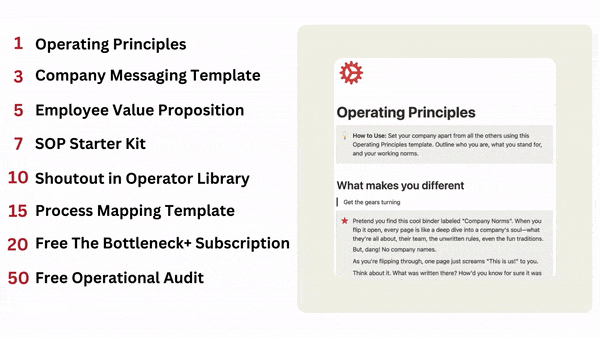
Read Time: 4.8 Minutes
Happy Sunday Operators ⚙️
I’ve had to learn many new skills over the past 10 days since my firstborn came.
Number #1?
Getting a baby to burp.
I’ve leaned on my parents to teach me how to handle a baby.
Whenever I’ve wanted to learn a new skill, I’ve relied on the experience of others or read up on the skill.
Are you interested in learning a new skill?
I’d recommend checking out The Bottleneck+
With the subscription, you get case studies of how successful companies scaled, lessons from the best business leaders and tools to help you keep your company running.
This is the last week to get your discounted rate for The Bottleneck+
After this week, I will bump prices to $17 a month. Click down below to get started.
While you get that upgrade, let's talk about how to get acquired like Airplane.

What is Airplane
Have you ever seen engineers build custom tools to help operators like us run our business?
They might have used Airplane.
Airplane is a platform designed to create internal tools for developers.
In a surprise to many, Airtable announced that they were acquiring (AKA acquihiring) Airplane.
“Acquihiring” refers to purchasing a company to recruit key employees and team members. This is unlike an M&A transaction, which focuses on increasing market share, owning intellectual property, or refining product strategy.
This business is more interested in your company’s talent than in your products and services. The purpose of the acquihire transaction is thus to secure access to your team’s specialized knowledge and skill set.
This was a surprise due to the amount of money the Airplane team had already raised.
Airplane's most recent financing, a Series B round in September 2022, brought in $32 million. At this point, Airplane had a team of 19 and was nearing 100 customers.
TechCrunch reported during the Series B announcement that Airplane wasn't profitable yet. The plan was to use the new funds and existing revenue could sustain their ambitious expansion plans.
Yet, these aggressive growth strategies seem to have fallen short. Airplane decided the challenges in securing additional funding due to high cash burn rates or failure to meet previous lofty expectations were too much to handle.
So what did Airplane decide to do?
Get acquihired by Airtable.
Why would Airplane even want to get acquihired?

Why should you care?
The number of company shutdowns has been steadily increasing.
Start-up shutdowns have occurred at the early Seed or Series A stages.
Yet, a new trend is emerging where more mature companies face closures at Series B and later stages. Many of these companies had secured substantial funding in 2021, giving them significant operational runway.
Yet, as we head into 2024, a rise in shutdowns among these firms will happen as financial runways shrink and additional fundraising becomes challenging.
Check out this chart by Carta to understand the blood bath right now.

Knowing this, Airplane's choice to pursue an acquihire by Airtable seems strategic.
This trend is evident among startups that experienced a surge in funding during the 'easy money' years.
In Airplane's case, the acquihire likely represents a calculated decision to extract value in a difficult market. The focus here is to transfer valuable team talent to Airtable.

How do you do this?
An acquihire agreement offers a dignified exit strategy for startups, preserving the essence of their mission and safeguarding their team's future. This approach is a strategic move for the acquiring company to quickly onboard a skilled and cohesive workforce.
Typically, the acquiring company transfers the real value in an acquihire to the employees through retention packages. Financial returns from the deal primarily benefit venture capitalists or investors with preferred stock due to their liquidity preferences.
In the case of Airplane, which raised $40.5 million, the proceeds from its acquisition by Airtable, which shares common investors with Airplane, likely went to these investors. This provides a smooth exit for Airplane and strengthens the VCs' relationship and investment portfolio.
If you’re in the market to be acquihired, follow these steps during due diligence and structuring your deal:
Understand Business Fundamentals: Discuss business history, product evolution, team, culture, and workflows with potential acquirers.
Identify Value Expectation Signals: Differences in cultures can disrupt once the integration occurs, so it is imperative to comprehend these issues early.
Create Data Room: Create a virtual data room to store all documents shared between both organizations
Assess Financial Health: Check cash, assets, liabilities, including employee obligations.
Team Goals and Expectations for the Transaction: Understand both team's aspirations and strengths.
Analyze Ownership Dynamics: Look at financing history and shareholder rights of both parties.
Evaluate the Team: Getting to know the team—as individuals—will in turn tell you a lot about how a company is run, and its overall potential fit within your organization “beyond the resume”:
Review HR Practices: Organizational structure, culture, compensation, and agreements.
Product and Technology Assessment: Understand company's mission, product, and IP.
Frame Deal Value: There are two primary categories to keep in mind as a framework for deal value: (1) employment consideration, which is the compensation for each team member (salary and bonus, equity, benefits) that should reflect your standard compensation packages paid to current team members; and (2) deal consideration, which may include retention payments to certain or all team members, as well as any potential additional consideration you may need to pay to the entity’s shareholders depending on several deal-specific variables.
Plan Deal Structure: Favor asset acquisition and avoid mergers/full acquisitions.
Develop a Retention Strategy: Identify key employees and prepare offer letters.
Simplify Transaction: Minimize liabilities and obtain legal releases.
Set Milestones and Objectives: Define transaction success metrics.
Prepare for Integration: Communication strategy, Day 1 logistics, and ongoing assessments.
Using this checklist can help guide you as you figure out the complicated process.

Spread The Word
Share The Bottleneck with friends to get a few freebies. Maybe you’ll make some new friends along the way 😆
We’ll give you free stuff and more friends if you share a link. Only one link.

{{rp_personalized_text}}

